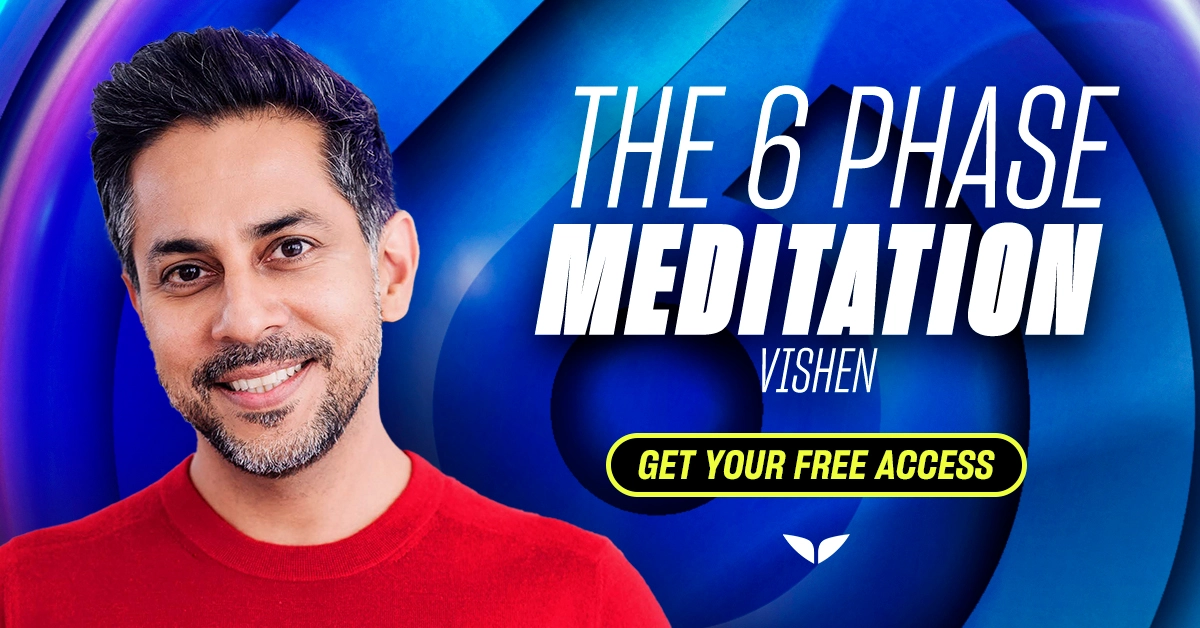Whether you’re trying meditation for the first time or you’re a seasoned pro, mantra meditation can have a profound impact on your practice.
But what are mantras for meditation? Or better yet, what is a mantra? And how can it be used to augment your spiritual, personal, and yes, even professional development?
You’ve probably heard the word mantra before. But what you might not know is that this is a spiritual practice that is as ancient as it is profound.
What is a mantra?
Simply put, a mantra is a word, sound, syllable, or phrase that is repeated over and over again during meditation. It is said to have a powerful vibrational resonance.
They’re used in meditation, yoga, and the spiritual practices of Buddhism, Hinduism, and Jainism.
What is the purpose of a mantra?
Music (including binaural beats), focusing on the breath, or focusing on an object are other ways of altering your consciousness, but there is something almost mystical about the sound of your own voice repeating a meditation mantra.
What is your personal mantra?
A personal mantra is a statement that motivates and inspires you to be your best self.
With a personal mantra, you affirm the way you want to live your life, as it often represents one’s core values. And it can help motivate you to complete your goals, both personally and professionally.
What is mantra meditation?
Meditation mantras are words or phrases you can sing, chant, hum, or repeat silently in your mind as you meditate. They come in many forms. Some are short, others are long. But they’re all designed to bring you into a state of deeper presence and awareness.
What is the purpose of mantra during meditation?
Mantras are a popular tool in meditation. They serve as an object of focus for the practitioner. Although many people use mantras, you can also use objects like candles, a bowl of water, a picture, or meditation music.
So, how do meditation mantras work? Why would repeating the same word or phrase over and over help you meditate?
Well, firstly, meditation mantras are designed to give the mind an object to focus on. When you have an object of focus, it becomes easier to steady the mind.
Secondly, ancient mantras have specific sound frequencies and meanings that soothe the senses and facilitate greater mindfulness. That’s why mantras have been used by sages and gurus around the world for many centuries.
What is a meditation phrase?
Meditation phrases are most commonly known as mantras. Most mantras are phrases. Repeat phrases that you find calming or that energize you. The most famous meditation phrase is most likely “Om Shanti”, meaning “peace”.
Sometimes, a mantra is a single word, like peace, emptiness, or abundance.
What do you say when you meditate?
Picking a mantra depends on your personal beliefs, interests, and, most of all, your goals.
When you select a mantra, you should find something that moves and motivates you. Something that will help you connect to what’s important in life. Something that will keep you calm and focused.
A mantra can be a word or a phrase that calms you and that you can easily chant to yourself, whether alone or with others.
If you want to explore some mantras yourself and you’re wondering, “What are some good mantras?” Well, ask no more, because below we’ve listed some tried-and-true mantras to help you use meditation for transformation.
Meditation is the solid foundation on which you build your spiritual temple.
But first, let’s cover the types of meditations that you can use mantras with.
What type of meditation uses a mantra?
There are many different types of meditation. But seven of the most prominent are:
- Mindfulness meditation
- Transcendental meditation
- Guided meditation
- Vipassana meditation
- Metta meditation
- Chakra meditation
- Yoga meditation
A mantra can be incorporated into any form of meditation practice. But traditionally, the two types of meditation that make use of mantras are transcendental and Metta meditations.
Transcendental meditation is a technique in which you sit with your eyes closed and repeat a mantra to yourself twice a day for 20 minutes.
The mantra that you use in transcendental meditation is the one that you choose for yourself and that has a positive effect on you. This can be a word or a phrase, but the mantra itself is entirely up to you. This technique will help you calm down and find inner peace and relaxation.
Metta meditation, or loving-kindness meditation, is one of many meditation mantras in which good wishes are directed toward someone else.
Unlock The 6 Phase Meditation program for free
Mantra meditation benefits
Meditation can be a transformative practice, and that has been confirmed by science. It is an excellent way to:
- Open and balance your chakras
- Concentrate your energy
- Boost self-knowledge
- Develop your psychic awareness
- Help pave the way for emotional healing
Some experienced meditation masters explain that these spiritual phrases, once unlocked, can raise your consciousness.
But using mantras for meditation involves a lot more than just sounding like a broken record. They’re generally sacred in nature—a name or sound that both uplifts you and helps keep you focused during meditation. Or, in other words, they’re designed to change you.
Mantras give your brain something to do. Yes, spiritual mantras are meant to transform you just by uttering them again and again, but there’s a lot to be said for saying something just to keep nonsense babble at bay.
And speaking of nonsense babble, rather than just giving you some meaningless drivel like “my shoes are green” or “I love pickled herring,” (which, for keeping your mind busy during meditation, does have its benefits. But let’s face it, this is “broken record” material and nothing more).

How to do mantra meditation for beginners (with examples)
Here’s how to start and stick with your practice:
- Find a quiet place.
- Set the intention for your meditation and begin your mantra—out loud or in your head.
- Simply repeat your mantra slowly and with intention. Remember, it’s not a race. You can say it as many or as few times as you’d like.
- Think about what your chosen mantra means. Dwell on the individual words.
- Let it resonate and vibrate with each syllable.
How to practice the loving-kindness mantra meditation
This form of meditation practice is a powerful one. Even if you’ve never tried it before, you’re bound to experience transformative results. Give it a try.
May I be happy. May I be well. May I be safe. May I be peaceful and free from suffering.
To practice the loving-kindness mantra meditation, find a comfortable spot, sit, relax, and after a few deep breaths, repeat these words for a couple of minutes.
After you’ve repeated this phrase for several minutes, picture a loved one in your mind’s eye and repeat the phrase again, but this time using “you” instead of “I.”
As you continue with this meditation, you can start to direct this practice of loving-kindness out into the world. Imagine those who have hurt you or who you have difficult relationships with.
As you direct kindness and love toward them, you can bring greater peace to both yourself and others.
9 ancient meditation mantras to try during your practice
Here is a quick list of nine of the most commonly used simple mantra words and phrases for meditation:
- “Aum” or “Om”
- “Ham-Sah” “
- Aham Prema”
- “Om Shanti, Shanti, Shanti”
- “Om Tat Sat”
- “Namo Amitabha”
- “I am That I Am”
- “I Love You; I’m Sorry; Please Forgive Me; Thank You”
- “I Want Nothing. I Do Nothing. I Am Nothing.”
Meditation mantras are a powerful way to increase your mindfulness during meditation. They serve as a focal point for your attention, the same way you might use a candle, a photo, or a statue.
There are quite a few meditation mantras you can access for free. The best part? They act as a form of guided meditation to help you stay grounded and present.
Let’s dive deeper into the nine mantras we mentioned above, outlining their benefits.
1. “Aum” or “Om”
Said to mean, variously: It Is, Will Be or To Become, The “Om” mantra is considered to be the most sacred mantra (and arguably the most commonly used). Om is a Sanskrit word that is meant to convey the “original vibration of manifestation”—in other words, when intention manifests in the physical realm.
This is one word that pretty much anyone can feel comfortable using, no matter your spiritual inclinations. It is an incredibly soothing sound, especially when you allow the vibration to linger in your throat. You can literally feel your body vibrate when you repeat this mantra for a little while!
It has been said that the true meaning of Om can only be understood by revelation. In other words, you have to say it to understand it. For starters, you can focus on the silence from which Om originates and into which it dissipates. That will quickly give your mind something to focus on and help you enter and stay in meditation!
Many meditation masters suggest that Om helps open your chakras as it simultaneously soothes the mind. You can say it yourself or listen to it as it’s sung or chanted, but this is a mantra best practiced out loud to receive the full benefits.
2. “Ham-Sah”
The Hindu variant, meaning I am THAT. This helps remind us that we are observers and, thus, helps detach from our human experiences and suffering.
3. “Aham Prema”
Meaning: “I am Divine Love.”
4. “Om Shanti, Shanti, Shanti”
Meaning: “Peace of mind, body, and speech.”
5. “Om Tat Sat”
Meaning: “All that is.”
6. “Namo Amitabha”
Meaning: Homage to the Buddha of boundless light.
7. “I am That I Am”
This is one of the Hebrew Torah’s most famous lines, and it was God’s answer to Moses when Moses asked for his name.
8. “I Love You; I’m Sorry; Please Forgive Me; Thank You”
This is the ancient Hawaiian mantra practice known as Ho’oponopono. According to the Hawaiian worldview, it means: “Forgiveness and reconciliation practice, cleansing of “errors of thought”—the origin of problems and sickness in the physical world.”
And it is a real heart-opener. By repeating these words, you open yourself up to clearing the stagnant energy trapped in your body.
These four short phrases are simple but powerful. By asking for forgiveness, you open yourself up to all sorts of transformative healing energy.
9. “I Want Nothing. I Do Nothing. I Am Nothing.”
This mantra was suggested by spiritual leader and Mindvalley teacher, Sri Sri Ravi Shankar. He explains that these three ideas are the golden principles of meditation.
Sri Sri suggests that you meditate on each phrase in turn. Meditate on each phrase for a few minutes, letting your body and mind sink into each.
This liberating meditation mantra can help free you from toxic attachments.
More examples of mantras
Now, just because mantras are a 3,000-year-old spiritual practice doesn’t mean they aren’t just as effective today as they were back then!
In fact, mantras have changed over the years to accommodate our modern attitudes and perceptions.
A mantra doesn’t need to be pronounced in Sanskrit to hold power. A mantra just needs to be something that resonates with you on a profound and personal level.
Mantras are often used in meditation as a way to stay focused and centered. But you can use mantras in lots of different ways.
Print one out to put up on your wall. Write one down on the community board at work. Slip a Post-it mantra into your friend’s purse for an added dose of inspiration.
18 popular modern mantra examples in English
- I am enough.
- Every day, in every way, I am getting stronger.
- I am a magnet for health, wealth, and happiness.
- I love you. I’m sorry. Please forgive me. Thank you.
- In me, I trust.
- I am open to the possibilities of the Universe.
- Disconnect to reconnect.
- I am in an attitude of gratitude.
- Inhale the future, exhale the past.
- I am the change.
- Everything I need is within me.
- I can and I will.
- I love myself, I believe in myself, I support myself.
- Life is short. Smile while you still have teeth.
- “I change my thoughts, I change my world.” — Norman Vincent Peale
- “Every day in every way I’m getting better and better.” — Émile Coué
- “Be the change you wish to see in the world.” — Gandhi
- “Love is the only miracle there is.” — Osho
The “love” and “I am” mantras
As you practice some mantras from this list or when you want to create your own mantra meditation, you’ll find that these two words tend to be incorporated into many others.
“Love”
Saying the word “love” while focusing on the feelings of love is a powerful way to create an atmosphere of love. Focus on the physical feeling you get when you say the word, “Love.” It’s such a great feeling! Even if you’re feeling depressed, angry, or upset, you can literally feel love washing over you when you repeat the word. Feel the love radiating outward from your heart…
“I Am”
This is the most powerful manifesting mantra. Think about it. Whenever you say, “I am sick,” how do you feel? Whenever you say, “I am happy,” how do you feel? In meditation, you can use “I am…” alone to honor and acknowledge your existence. And you can take it a step further and honor and acknowledge your divinity and oneness with all that is.
You can also add positive affirmations while you meditate to help paint a mental picture of what you want out of life. For example, “I am a successful [what you want to be]” and so on.
It all started with the ancient Hindus, but the use of mantras for meditation has since spread—mostly through the Far East—among Buddhists, Taoists, Sikhs, and others. Today, Western peeps on a spiritual path also create mantras.
Many of them seem more like affirmations, but the ones that are short and sweet still work nicely for that all-important transformative effect.
3 traditional Buddhist mantras for mindfulness, presence, and power
The very first mantras were used by Hindus in India over 3,000 years ago. Several hundred years later, after Buddhism began to flourish, mantras began to be incorporated into their spiritual practice too.
Buddhist mantras are based on the holy teachings of the Buddha and the bodhisattvas.
Here are three traditional Buddhist mantras you might not have heard of before:
1. “Om Mani Padme Hum”
This one’s from Tibet, and it means, roughly, “Hail the Jewel in the Lotus.” The jewel, in this case, is the Buddha of Compassion. This mantra is used in Tibetan Buddhism.
This is a practice of compassion. It’s used to seek and spread empathy for oneself and others.
2. “Om Muni Muni Mahamuni Shakyamuniye Svaha”
This means, “I invoke the Universal sound, Buddha-nature, and the wise one, wise one of the Shakyans, hail to thee!”
Also called the Shakyamuni Mantra, this mantra is meant to encourage the development of what Buddhists call “Buddha-nature,” or the seeking of Enlightenment.
3. “Om Vasudhare Svaha”
Also called the Buddhist money mantra, it’s used as a prayer to the bodhisattva of earth and abundance, Vasundhara. In Buddhism, it’s thought to be the embodiment of the feminine spirit and is the counterpart to the Hindu goddess Lakshmi.

What is mantra healing?
It’s been proven that chanting, music, and mantras have a strong impact on our brains.
In fact, according to Deva Premal and Miten, mantras are energetic sound formulas that slow us down and allow us to see everything clearly. They give us perspective.
Dr. Alfred A. Thomas from the Paris School of Medicine claims that chanting calms the body and activates a number of natural bodily functions and processes. It can also help in healing the mind and body from addictions like smoking or alcohol. What’s more, chanting can strengthen the immune system.
Additionally, Dr. Watkins, a senior lecturer in neuroscience at the Imperial College of London, found that chanting can lower blood pressure, reduce stress levels, increase hormone level performance, and decrease anxiety and depression.
Who would have thought that this simple practice could have such power?
Just remember that in the process of finding a pull and fascination for healing others, you, yourself, can become healed.
Om Shanti meaning in yoga
Om Shanti is perhaps one of the most well-known and accessible mantras used today. If you’ve ever set foot in a yoga class, chances are you’ve heard it.
So, what does Om Shanti mean? Well, there’s actually no direct translation for Om Shanti. That’s because Om isn’t so much a word as it is a sound, a feeling, and an energetic resonance.
Om is said to be the sound of the universe. This single syllable encompasses the cycle of death and rebirth. Chanting the word Om brings you into energetic alignment with the universe.
So, what about Shanti? Well, Shanti is a Sanskrit word that means “peace.” Together, the Om Shanti meaning is meant to convey: Universal Peace.
It’s often used as a greeting in yoga as a way of acknowledging a fellow practitioner and wishing them peace.
Make meditation a habit
When it comes to sticking to your meditation practice, it’s crucial to let go of the myths that may be holding you back.
If you want to learn how to prime yourself for effective meditation, enroll in The 6 Phase Meditation course with Vishen, Mindvalley founder and world-renowned meditation expert.
Thanks to this transformative practice, hundreds of Mindvalley members raised their levels of energy, achieved goals, enhanced their intuition, and more.
Ready to try it for yourself? Welcome in.








